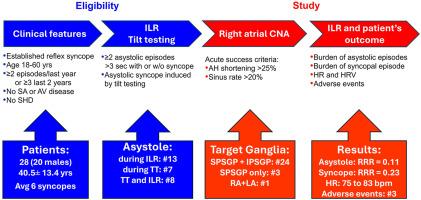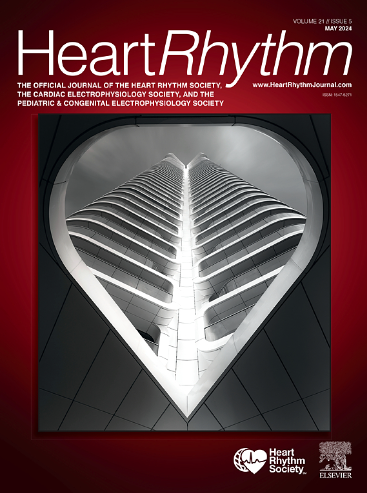Right atrial cardioneuroablation of asystolic reflex syncope
IF 5.7
2区 医学
Q1 CARDIAC & CARDIOVASCULAR SYSTEMS
引用次数: 0
Abstract
Background
Cardioneuroablation (CNA) should focus on the vagal ganglia located in the right atrium close to the sinoatrial and the atrioventricular nodes.
Objective
The study aimed to evaluate the efficacy and safety of right atrial CNA.
Methods
Patients with severe, asystolic reflex syncope identified by implantable loop recorder (ILR) or tilt testing underwent right atrial CNA and were subsequently monitored using ILR.
Results
The population included 28 patients with a mean age of 40.5 ± 13.4 years, of whom 71% were men. Over a median follow-up period of 12.5 months, 8 patients experienced 44 episodes of asystole lasting longer than 3 seconds, as recorded by an ILR. The burden of asystolic episodes significantly reduced from 0.89 episodes per month before CNA (145 over 163 patient-months) to 0.11 episodes per month after CNA (44 over 397 patient-months), with a relative risk reduction of 0.12, P = .0001. Similarly, the burden of syncopal episodes decreased from 0.23 episodes per month before CNA to 0.06 episodes per month after CNA, resulting in an relative risk reduction of 0.24, P = .0001. Median heart rate increased from 75 bpm (interquartile range: 72–79) before ablation to 83 bpm (interquartile range: 78–85) after ablation, lasting up to 9 months post-procedure. No patients experienced complications during the procedure. During follow-up, 2 patients received pacemakers, 1 underwent a redo procedure, and 4 experienced mild transient symptoms: 3 had palpitations and 1 had dyspnea, none requiring therapy.
Conclusion
Right atrial CNA reduced asystolic episodes by 88% and syncopal episodes by 76% during the mid-term follow-up. Adverse events were infrequent and mild.

无收缩期反射性晕厥的右心房神经消融术。
背景:心脏神经消融(CNA)应集中于位于右心房靠近窦房结和房室结的迷走神经节。目的:评价右心房CNA的有效性和安全性。方法:通过植入性环路记录仪(ILR)或倾斜试验确定的严重无收缩反射性晕厥患者行右心房CNA,随后用ILR监测。结果:本组患者28例,平均年龄40.5±13.4岁,男性占71%。在12.5个月的中位随访期间,根据ILR记录,8例患者经历了44次持续时间超过3秒的心脏骤停。心脏骤停发作的负担从CNA前的每月0.89次(145 / 163患者-月)显著降低到CNA后的每月0.11次(44 / 397患者-月),相对风险降低(RRR)为0.12,p=0.0001。同样,晕厥发作的负担从CNA前的每月0.23次下降到CNA后的每月0.06次,RRR为0.24,p=0.0001。中位心率从消融前的75 bpm (IQR: 72-79)增加到消融后的83 bpm (IQR: 78-85),持续9个月。手术过程中无患者出现并发症。在随访期间,2名患者接受了起搏器,1名患者接受了重做手术,4名患者出现了轻微的短暂症状:3名患者心悸,1名患者呼吸困难,均不需要治疗。结论:在中期随访中,右心房CNA减少了88%的心脏骤停发作和76%的晕厥发作。不良事件罕见且轻微。
本文章由计算机程序翻译,如有差异,请以英文原文为准。
求助全文
约1分钟内获得全文
求助全文
来源期刊

Heart rhythm
医学-心血管系统
CiteScore
10.50
自引率
5.50%
发文量
1465
审稿时长
24 days
期刊介绍:
HeartRhythm, the official Journal of the Heart Rhythm Society and the Cardiac Electrophysiology Society, is a unique journal for fundamental discovery and clinical applicability.
HeartRhythm integrates the entire cardiac electrophysiology (EP) community from basic and clinical academic researchers, private practitioners, engineers, allied professionals, industry, and trainees, all of whom are vital and interdependent members of our EP community.
The Heart Rhythm Society is the international leader in science, education, and advocacy for cardiac arrhythmia professionals and patients, and the primary information resource on heart rhythm disorders. Its mission is to improve the care of patients by promoting research, education, and optimal health care policies and standards.
 求助内容:
求助内容: 应助结果提醒方式:
应助结果提醒方式:


